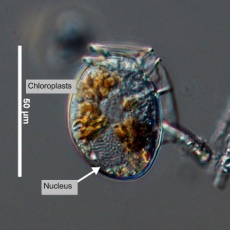
|

|
| D. acuminata | D. acuta |

|

|
| D. fortii | D. parva |
Classification
(Guiry and Guiry 2012)
Lifestyle
Description
Measurements
Width: 22 - 66 μm
(Horner 2002)
Key to local species
Posterior
The back end of a cell. Opposite of anterior.
posterior sides meeting at acute angle, a fairly sharp tip and widest below the middle section. D. acutaHarmful effects
Lipophilic
Having the ability to combine with or dissolve lipids.
lipophilic toxins (okadaic acid derivatives and pectenotoxins) causing diarrhetic shellfish poisoning (DSP), which affects humans (Hoshial et al. 2003).Habitat
Distribution
Environmental Ranges
Temperature range (°C): -1.314 - 28.429
Nitrate (μmol L-1): 0.551 - 10.777
Salinity: 18.564 - 39.252
Oxygen (mL L-1): 4.915 - 9.116
Phosphate (μmol L-1): 0.048 - 0.745
Close
Silicic acid
A general term to describe chemical compounds containing silicon, oxygen and hydrogen with a general formula of [SiOx(OH)4-2x]n. Diatoms polymerize silicic acid into biogenic silica to form their frustules (Azam and Chisholm 1976).
Silicate (μmol L-1): 0.754 - 36.110(EOL 2012)
References
Dodge J. D. 1982. Marine Dinoflagellates of the British Isles. Her Majesty's Stationary Office, London, UK. 303.
Encyclopedia of Life (EOL). 2012. Dinophysis fortii Pavillard 1923. http://eol.org/pages/901388/overview. Accessed 18 Sept 2011.
Guiry, M. D. and Guiry, G. M. 2011. Dinophysis fortii Pavillard 1923. http://www.algaebase.org/search/species/detail/?species_id=52238. Accessed on 18 Sept 2011.
Horner, R. A. 2002. A Taxonomic Guide To Some Common Phytoplankton. Biopress Limited, Dorset Press, Dorchester, UK. 200.
Hoshial, G., Suzuki, T., Kamiyama, T., Yamasaki, M. and Ichimi, K. 2003. Water temperature and salinity during the occurrence of Dinophysis fortii and Dinophysis acuminata in Kesennuma Bay, northern Japan. Fisheries Science. 69: 1303-1305.
